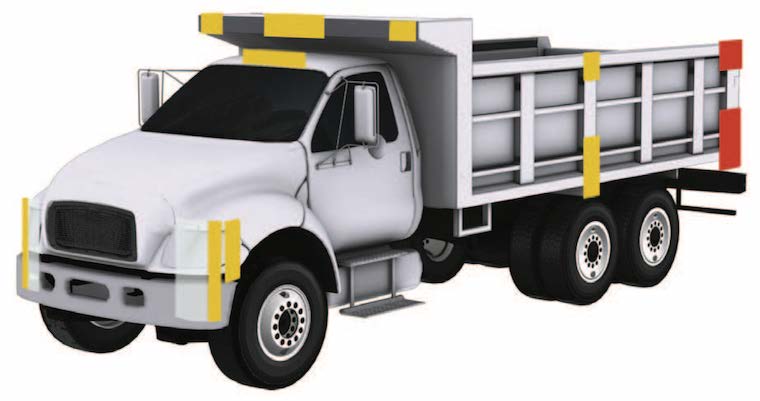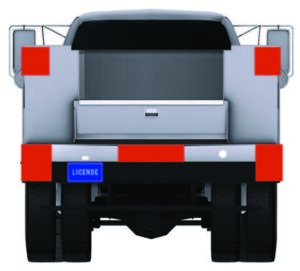Work Truck Lighting Requirements

By Bob Raybuck
Today, a nearly limitless variety of work trucks — with a multitude of bodies, equipment and accessories — are available. This means it can be challenging for upfitters (final-stage manufacturers and alterers) to properly meet all lighting requirements under Federal Motor Vehicle Safety Standard (FMVSS) 108: Lamps, Reflective Devices and Associated Equipment, and Canadian Motor Vehicle Safety Standard (CMVSS) 108: Lighting Systems and Reflective Devices.
Fortunately for upfitters and commercial vehicle customers alike, U.S. and Canada (F/CMVSS 108) lighting requirements are almost identical. (Note: CMVSS 108 has additional requirements for daytime running lights and more options regarding conspicuity treatment for heavy trailers.)
End-users

When spec’ing additional equipment, auxiliary lighting, and other options designed to ensure a work truck performs its intended function, there may be conflicts in meeting lighting requirements (in terms of visibility, location and function) — and required lighting under F/CMVSS 108 will take precedence. For example, if the specific vehicle design calls for warning/strobe lights, the location, brightness and function of these added lights cannot impede the location, optical visibility, light intensity or function of required lighting under F/CMVSS 108. Otherwise, auxiliary lighting must be relocated and/or supplemental compliant lighting must be added to fulfill lighting standard requirements.
Similarly, when adding equipment, it’s important to ensure performance of required lamps is not affected. This is common with installations of snow control equipment, liftgates, etc.
Upfitters
While F/CMVSS 108 lighting requirements are among the most involved of all the safety standards (light intensity, color, durability, light disbursement pattern, etc.), most of these requirements are met by lighting equipment manufacturers. The final-stage manufacturer or alterer is using the lighting manufacturer’s certification of a lamp’s designed performance to meet FMVSS 108 requirements by correctly positioning it on the truck.
Additionally, the final-stage manufacturer or alterer must ensure the proper number of lights is used. Since clearance and identification lights cannot be combined on the rear of the vehicle, it’s imperative to have the proper number of lights and reflective devices. Proper location of the lights is dependent on vehicle design and where they are required to meet visibility requirements. Examples of equipment that may impede lamp visibility are cone holders, equipment bags, etc. This issue may require alternative locations to be chosen for the equipment.
Additional considerations
Due to visibility requirements, most stop, turn and taillights need to be at the rearmost part of the vehicle. Clearance lamps and reflectors (front and rear) must show the full width of the vehicle first and then be as high as practical (note, items like mirrors may require front clearance lights to be lowered). A common misconception is that conspicuity treatment (red and white alternating reflectors) or reflective tape is required on all commercial vehicles. However, conspicuity treatment is only required on semi-tractors and semi-trailers, not straight trucks.
When installing worklights, strobes, and other items typically used when the vehicle is stopped, be cautious not to block or overpower F/CMVSS 108 required lighting. Many strobes and worklights are brighter than stop and turn signal lamps, which can mask required brightness (luminous intensity) and cause failure to meet F/CMVSS requirements. For example, on vehicles with LED daytime running lights, the headlights will turn off on the side on which the turn signal is activated because the headlamp’s luminous intensity will mask turn signal effectiveness.
F/CVMSS 108 has specific requirements for minimum and maximum heights of lights and reflectors on a vehicle. Visit ntea.com/lightingguide to access NTEA’s interactive U.S./Canada Federal Lighting Guide, which offers information on placement of required lights and reflectors.
Bob Raybuck, is director of technical services at NTEA.Established in 1964, NTEA, The Association for the Work Truck Industry, represents more than 2,100 companies that manufacture, distribute, install, sell and repair commercial trucks, truck bodies, truck equipment, trailers and accessories. Buyers of work trucks and the major commercial truck chassis manufacturers also belong to the Association. NTEA provides in-depth technical information, education, and member programs and services, and produces The Work Truck Show®.
Learn more
NTEA offers access to publications and reference materials on current regulations, safety standards, and other technical issues at ntea.com. To learn more about the tools, resources and solutions available to members, visit ntea.com/memberbenefits. Contact NTEA’s technical services team at info@ntea.com or 800-441-6832.


